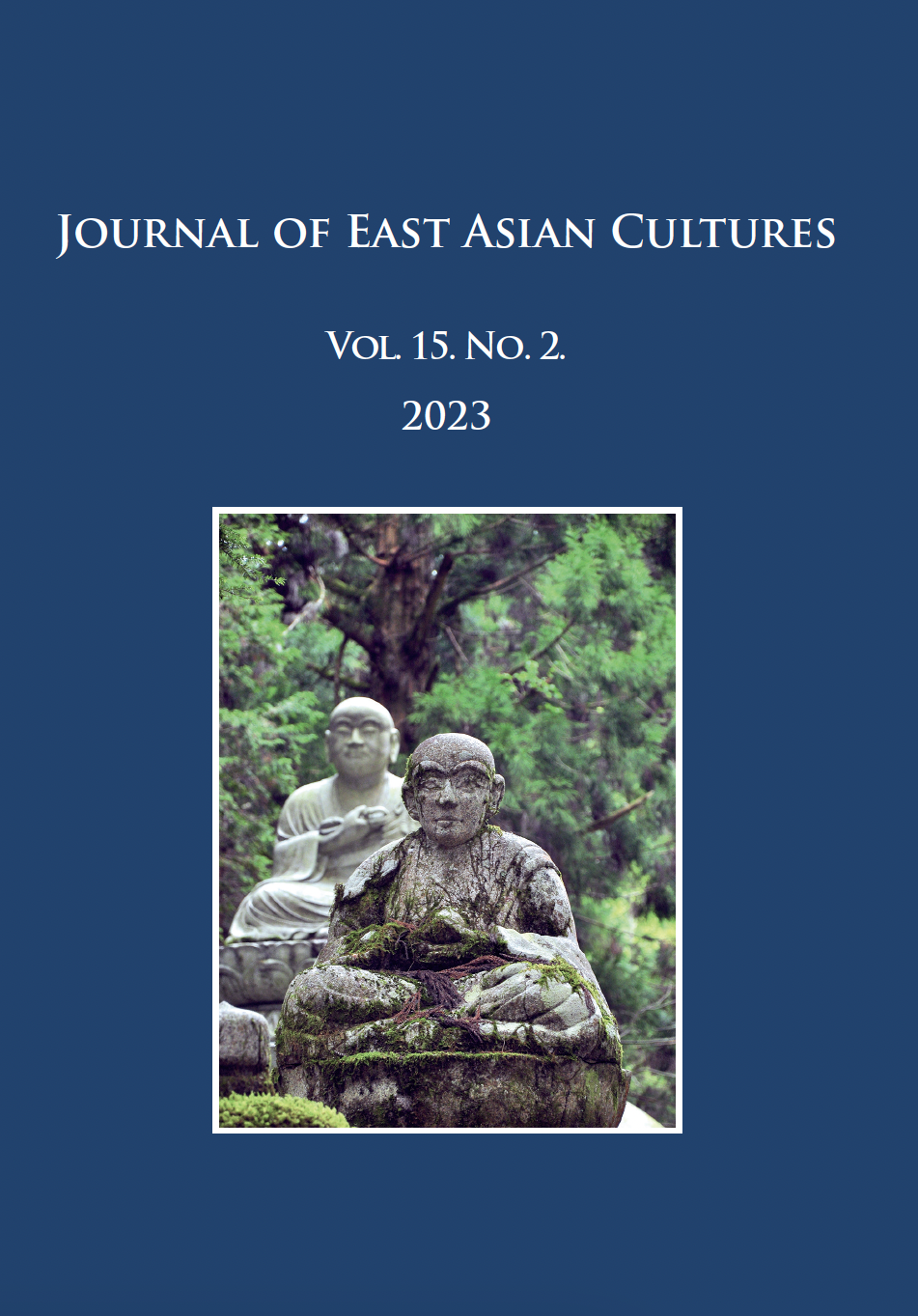Heian Period Developments in Japanese Esoteric Buddhist Practice: The Case of the Fugen Enmei Ritual and its Various Honzons
Megjelent 2023-09-30
Kulcsszavak
- ezotericizmus,
- ezoterikus buddhizmus,
- japán buddhizmus,
- Fugen bódhiszattva,
- Fugen Enmei
- Szamantabhadra,
- Honzon,
- buddhista rituálé,
- Heian-kor ...Tovább
Hogyan kell idézni

This work is licensed under a Creative Commons Attribution-NonCommercial 4.0 International License.
Absztrakt
The present paper addresses esoteric Buddhist rituals in Japan, with special focus on the changes that happened in its practice in the first couple of centuries after its initial arrival to the country. Although esotericism originated in India, it was the brief spotlight it gained in China during the Tang Dynasty (especially in the 8th century) that determined its transmission to Japan in the beginning of the 9th century, where it spread rapidly and reached a particular culmination within the same time period, i.e., the Heian Period (794 to 1185/1192). On the one hand, the Shingon school, established by the monk Kūkai (774-835), was essentially the first time the esoteric Buddhist teachings were systematised, and although the founder’s person and teachings are still very much revered to this day, changes have begun right after his death in 835. On the other hand, the Tendai school, a rival for imperial recognition and support and also established (or rather introduced) in the beginning of the 9th century by the monk Saichō (767-822, a contemporary of Kūkai) included some esoteric teachings, and with the practices introduced by later Tendai monks, such as Ennin (794-864) or Enchin (814-891), this school cultivated esoteric practices that are still extant in Japan today.
Firstly, the meaning and usage of the honzon (an icon of a deity) in esoteric Buddhist rituals is clarified in the paper, while later the evolution of two specific icons that were used during the Fugen Enmei rituals of both the Shingon and Tendai schools is introduced, with explanations as to why there are two different types of iconographies extant for the same kind of ritual. The paper contributes to the study of those esoteric practices that were created and developed in a locally recognized Buddhist milieu that served specific purposes in Japan and are found in no other Buddhist cultures in Asia.
Hivatkozások
- T Taishō Shinshū Daizōkyō
- TZ Taishō Shinshū Daizōkyō Zuzō
- Asabashō 阿娑縛抄, Shōchō 承澄, TZ volume 9: 864c01–873a10.
- Fugen Enmei hō hiki 普賢延命法秘記 [Secret Commentary on the Fugen Enmei ritual]. In: Shōhen (ed.) Shōhen oshō zenshū 照遍和尚全集 (The collected writings of the High Priest Shōhen). Kawaue: Shōhen Oshō Zenshū Kankōkai, 1930–1932.
- Kakuzenshō 覚禅鈔, Kakuzen 覚禅, TZ volume 5: 101b01–119b25.
- Mon’yōki 門要記, TZ volume 11: 631b01–689b17.
- Andreeva, Anna 2014. ‘Childbirth in Aristocratic Households of Heian Japan.’ Dynamis 34.2: 357–376. https://doi.org/10.4321/S0211-95362014000200005
- Goepper, Roger 1979. ‘Some Thoughts on the Icon in Esoteric Buddhism of East Asia.’ In: Bauer, Wolfgang (ed.) Studia Sino-Mongolica: Festschrift für Herbert Franke. Wiesbaden: Franz Steiner Verlag, 245–254.
- Inoue Mitsuhisa 井上光央 1972. ‘Honzon to wa nanika 本尊とは何か [What is the Honzon?],’ Daibyaku renge 大白蓮華 254: 32–35.
- Kanbayashi, Ryūjō 神林隆浄 1929. Mikkyōgaku 密教學 [The Study of Esoteric Buddhism]. Tokyo: Heigo Shuppansha.
- Kiss Mónika 2014. ‘Fugen Enmei bosatsu ikonográfiai meghatározásának néhány problematikus pontja [Problematic Points in the Iconography of Fugen Enmei Bosatsu].’ Távol-Keleti Tanulmányok 2014/1–2: 67–92.
- Kiss Mónika 2019. ‘Fugen Enmei kínai eredete – Két indiai mester, két hagyomány? [The Chinese Origins of Fugen Enmei – Two Indian Masters, Two Traditions?]’ In: Csibra Zsuzsanna (ed.) Művészet, vallás, kultúra – Sinológiai tanulmányok Miklós Pál emlékére (Konfuciusz Könyvtár 3), Budapest: ELTE Konfuciusz Intézet, 173–187.
- Kiss Mónika 2021. ‘The Fugen Enmei Scripture: Samantabhadra Becomes a Deity for Longevity,’ Journal of the International College for Postgraduate Buddhist Studies 25: 111–141.
- Matsumoto, Ikuyo 松本郁代 2008. ‘Chūgū osan to mikkyō: ’Hōhiki’ Sonshōō hō mishihō wo megutte 中宮御産と密教―『宝秘記』尊星王法御修法をめぐって Birth in the Imperial Palace and Esoteric Buddhism – Focusing on the Sonjōō Ritual in the Hōhiki].’ In: Abe Yasurō 阿部泰郎 (ed.) Nihon ni okeru shūkyō tekisuto no shoisō to tōjihō 日本における宗教テクストの諸位相と統辞法 [Various Registers and Syntax Methods of Japanese Religious Texts]. Nagoya: Nagoya Daigaku Daigakuin Bungaku Kenkyūkai, 81–88.
- Nagaoka, Keishin 長岡慶信 1964. Mikkyō gaisetsu 密教概説 [An Outline of Esoteric Buddhism]. Tokyo: Rokuyaon.
- Nara Kokuritsu Hakubutsukan 奈良国立博物館 (ed.) 2014. Daigoji no subete 醍醐寺のすべて [All of the Daigoji Temple]. (Exhibition catalogue.) Nara: Nara Kokuritsu Hakubutsukan.
- Sharf, Robert H. 2001a. ‘Prolegomenon to the Study of Japanese Buddhist Icons.’ In: Robert H. Sharf – Elizabeth H. Sharf (eds.) Living Images: Japanese Buddhist Icons in Context. Stanford, CA: Stanford University Press, 1–18.
- Sharf, Robert H. 2001b. ‘Visualization and Mandala in Shingon Buddhism.’ In: Robert H. Sharf – Elizabeth H. Sharf (eds.) Living Images: Japanese Buddhist Icons in Context. Stanford, CA: Stanford University Press, 151–197.
- Ueda Reijō 上田霊城 1989. Shingon mikkyō jisō gaisetsu: Shin anryū wo chūshin toshite 真言密教事相概説: 新安流を中心として [An Outline of the Aspects of Shingon Esoteric Buddhism: Focusing on the Shinanryū Branch]. 3 vols. Kyōto: Dōhōsha.
- Uekawa Michio 上川通夫 2008. ‘Nyohō sonshō hō shōkyō no seisei 如法尊勝法聖教の生成 [The Formation of the Sacred Teachings of the Nyohō sonshō Ritual].’ In: Abe, Yasurō 阿部泰郎 (ed.) Nihon ni okeru shūkyō tekisuto no shoisō to tōjihō 日本における宗教テクストの諸位相と統辞法 [Various Registers and Syntax Methods of Japanese Religious Texts]. Nagoya: Nagoya Daigaku Daigakuin Bungaku Kenkyūkai, 74–80.

